This website has been archived from TrainWeb.org/eritrean to TrainWeb.US/eritrean.
This website has been archived from TrainWeb.org/eritrean to TrainWeb.US/eritrean.
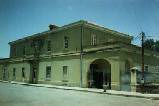
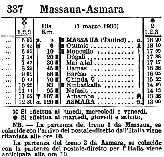
The station crowd waiting for the morning littorina represented this cross section...Eritrean (in those days we called them Ethiopian) men in their spotless white tunics and pants; Eritrean woman with white scarves and dresses; a Moslem man dressed as a Bedouin; a woman dressed from head to toe in black...probably from the Rashaida regions [I was told at the time that the woman was from Afar...it wasn't till much later I discovered that Afar was an ethnic group in Eritrea. I believe my leg was being pulled because the woman was Moslem]; an Ethiopian police officer dressed in khaki with spats, bush hat, bandoleers, and the inevitable Enfield rifle; two Italian girls barely older than my 19 years...one was blond and the other brunette; a mid-teen, light skinned Ethiopian boy dressed in European clothing... Possibly, he was a caffelatte...of mixed European and Ethiopian descent; an Italian businessman, a middle-aged male of undetermined European origin; and of course my friend and me...two GIs. Somewhere unseen was the driver. When he showed, he was dressed in a near military uniform.

That morning, the rail yard next to the station was near empty. I remember a coach or two. There was at least one goods wagon. There were at least two cars that were coupled together as I have this picture of their links and buffers.
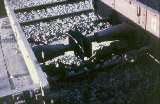
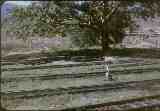

For much of the journey, the policeman stood in the baggage area so that he could watch for shiftas. My friend and I took one booth near the driver on the opposite side of the car. Across the aisle was the Rashaida woman and another Muslim group. The two Italian girls took the booth kitty-corner from us. The remaining booth on our end was filled with Eritreans. I can't remember how many, but I think there were two women and a man. The teenager scooted about the car. I am not quite sure where he sat. He looked over the drivers shoulder some of the way and sat in the driver's seat at the other end for some other portion of the trip.
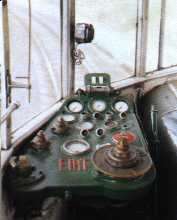
The first kilometer or so was like a rail trip anywhere. Houses and light industry were along side the tracks. There were a few at grade crossings where we held up traffic.
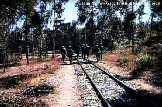
Finally, it opened into the first valley. At the right hand side of the littorina, the mountain rolled down perhaps 500 meters to the valley floor.
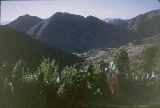
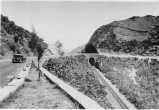
Devil's Doors |
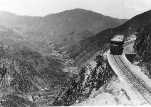
Mai Henti Valley |
This curve shows up in several pictures of the Eritrean Railway which are on the World Wide Web.

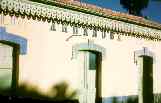
Littorina's path danced with an abandoned ropeway which also lead from Asmara to Massawa. Up until the middle of the 1960s, the official name of the line was The Eritrean Railway and Cableway. The cableway had been abandon since at least when the British left in 1952. The first meeting with the cableway which I remember was just before we got to Nefasit.
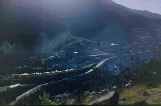
The most dramatic moment of the trip was when we rounded the mountain and looked down the Asmara Escarpment upon Nefasit. The view was breath taking. Looking at Nefasit with a steam train waiting for us was like looking down on someone's model railroad.
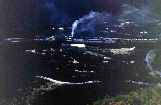
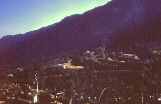

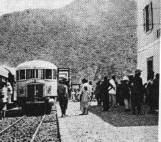
From Nefasit, the tracks meandered back and forth through a valley. The drop from Nefasit to Ghinda was a few thousand feet at a near constant grade. Between Nefasit and Ghinda was the village of Embatkala.
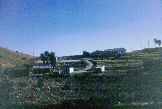
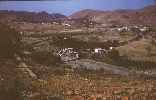
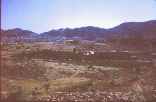

In Ghinda, the train stopped for quite some time. I bought a kilo of tangerines at the snack bar there.
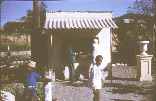
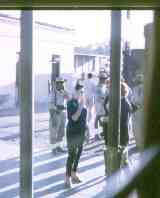
I think they were watching us as much as we were watching them...they were just more discrete about it. Two other girls joined them.
Soon after Ghinda, we went over a rise and then started down. Sometime after starting down, we followed a dry riverbed.
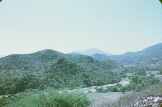
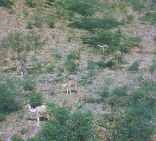
Soon, we hit the flats. This is a region of about 20 kilometers is slightly
more hilly than Kansas. There are less than a dozen acacia per square kilometer
and little other vegetation. Here the vegetation took on more of a brownish
tinge than we had been seeing.
Within a half-hour of hitting the flats, the windows started opening as the inside of the car was rapidly approaching the 60° outside.


Although we called it a hotel, it probably was technically a pensione. It was a self procaimed "grand hotel." This building had been prefabricated in Italy and shipped to Massawa for assembly before World War II. In the early 1960s, it was used as a US Army Rest Center. It had ceiling fans that I found quite exotic at the time. They were all but unheard of in the States. It gave an aura of "Casablanca." I don't think I ever heard anyone play "As Time Goes By" on the piano.
Army Special Services showed movies on the verandah at night. There was a sea water swimming pool. While the restaurant or club portion was air-conditioned and there were room air conditioners in the rooms, the halls and the central bathrooms were not. One strange thing to me was that while there were private sinks and showers, there were not private toilets.
Reconstructing a train trip from memories of over 37 years is not an easy task. Some things about the trip are strong. Others are absent. I made two trips on littorine from Asmara to Massawa. One was in November of 1961. The other was the following July or August. Only once did I make the return trip on Llittorina. Only once did I take pictures. The other time, I rode back in someone's pre-World War II small FIAT. I always thought these were called Topolino.
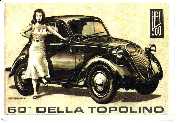
SEARCH
All copyrights remain with the original sources. No permission
is granted for further use with out their expressed consent

Home |

Scrapbook |
| Who | What | Why | When | Where |